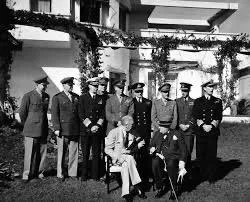2-SECOND BURSTS
SHORT THOUGHTS ON LEADERSHIP, DECISION-MAKING, FLIGHT, AND OTHER TOPICS OF THE DAY
ARTICLES

Commander's Intent
World War II was a mammoth effort in leadership at many levels. Part of the challenge was obtaining alignment between the different nations and their individual self-interests regarding the war. Each had paid a high price of different types even early in the war, and the leaders represented the desires of their people and nations based on the differing concerns and costs thus far. Each viewed the desired outcome based on the perceived threats and needs of their own people in a post-war world. Additionally, each nation faced differing ongoing challenges for their own safety and the protection of their resources. For example, many in the United States wanted a “Pacific first” approach to punish the Japanese for the offensive action in Hawaii and other US territories, to recover the captured Americans taken by the Japanese, and secure their West Coast and island territories.Churchill and England wanted shift the German forces focus from their shores as they occupied France, Belgium and Holland. The Soviet Union was in a fight for its life in Eastern Europe, with Germany deploying 148 Divisions against their homeland, combined with several Axis allies that contributed to a total force of 3.5 million men on the Eastern front of the war. Each disparate set of interests pulled the Allied forces in different directions, and they needed a unified vision to ensure overall victory.
At the Casablanca Conference in January 1943, the Allied Powers formally adopted “unconditional surrender” as the desired end-state for the cessation of hostilities and the end of the war.This vision of what the end of the war looked like drove allocation of resources, created somewhat of a unity of effort, and provided a guide for every military commander and their prosecution of the war in their area of operations. With this decision, they were no longer separate forces that happen to be fighting the same enemies. They were a unified force that, at least in part, coordinated efforts, combined forces, and worked together for their common vision. As described in Army doctrine (footnote Army Doctrine Reference Publication 5-0) the commander’s intent “succinctly describes what constitutes success for the operation. In effect, it is forward-looking, success-oriented and aspirational in nature. It is the leader’s overarching view of what success looks like and provides subordinate teams and leaders a guide to then define success within their own area of responsibility. Commander’s intent is nothing more than the leader’s vision of where they want to go. With foundational principles as a guide, a leader now has a few key actions that will develop confidence in a team in all directions. These actions will provide a cohesion, unity of effort, a confidence in individual and team roles, and a mechanism of perpetual improvement. These key actions are Vision, Trust, and an Integrated Debrief.

CONTACT DEREK!

MEDIA INQUIRIES
Members of the press are welcome to contact us regarding any requests at [email protected] ;
(385) 777-6285

